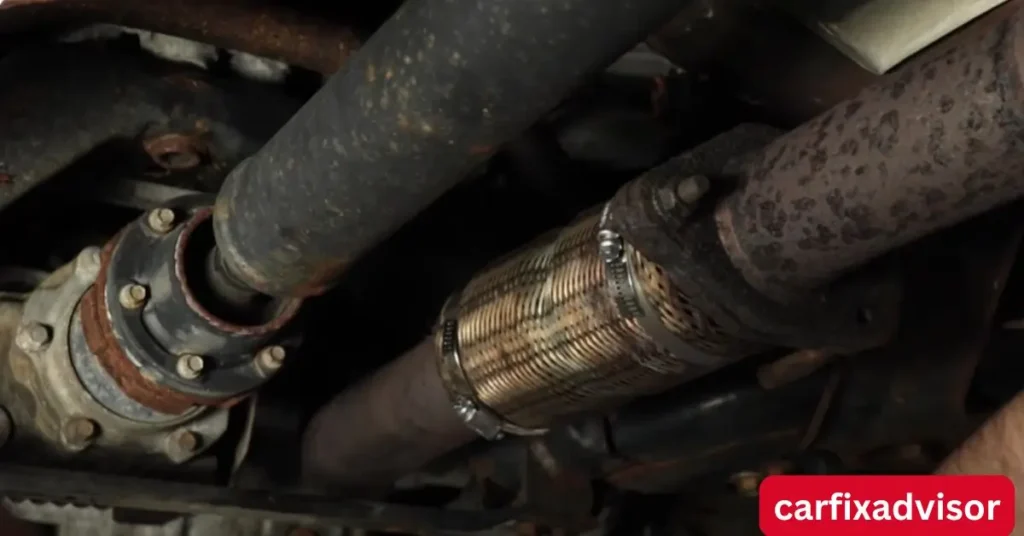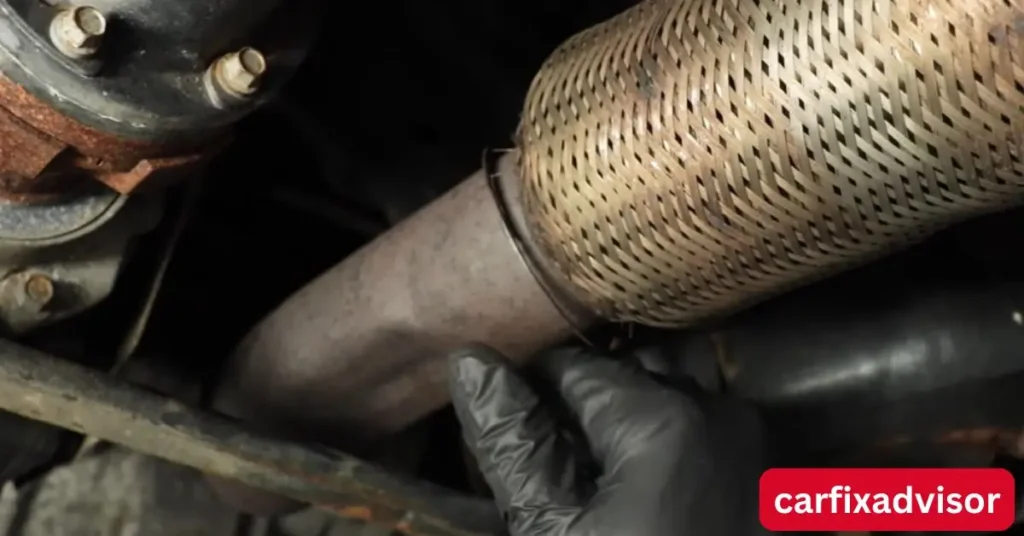Hearing an odd scraping noise or feeling a sudden vibration while driving could be more than just a small inconvenience—it could be a sign that your car’s heat shield is dragging on the road. This problem is more common than you might think, and it’s one that should not be ignored, as it can lead to further damage to your vehicle and compromise its performance.
In this article, we will delve into what a Heat Shield Dragging Under Car is, why it may become loose or damaged, and what to do when the heat shield is dragging under your car. We’ll also discuss the potential consequences of driving with a damaged heat shield and how you can fix it quickly and efficiently.
What is a Heat Shield?
A Heat Shield Dragging Under Car is a vital component in your car’s undercarriage designed to protect various parts of the vehicle from excessive heat. It’s primarily located around the exhaust system, including the catalytic converter, muffler, and exhaust pipes, but it may also be found near other areas of the vehicle that generate high heat.
Purpose of a Heat Shield:
-
Protection from Heat: The heat shield serves as a barrier to protect critical parts of the car, such as the fuel lines, wiring, and even the floor of the cabin, from heat damage.
-
Preventing Fire Hazards: The heat shield prevents the high temperatures generated by the exhaust system from coming into direct contact with flammable materials, thus reducing the risk of fire.
-
Noise Reduction: In addition to heat protection, the heat shield also helps minimize noise produced by the exhaust system, especially in older cars.
The shield is typically made of durable materials like aluminum or stainless steel, designed to withstand high temperatures without deteriorating quickly.
Why is My Heat Shield Dragging Under My Car?
If you’re noticing a scraping sound or vibration from under the car, the issue may be that the heat shield is loose or damaged. Several factors can lead to this problem, ranging from general wear and tear to external impacts while driving. Let’s take a closer look at some of the most common reasons your heat shield might become loose or detached.
1. Corrosion or Rust
Over time, exposure to moisture, road salt, and other elements can cause the heat shield to corrode or rust. When rust builds up, it weakens the shield and may cause it to detach from the vehicle. As the shield becomes looser, it may begin to drag along the road.
-
Symptoms of Corrosion: You may notice the shield is visibly rusted, or the car makes a scraping noise when driving over bumps or rough roads. This is often the result of the shield’s fasteners weakening due to rust.
-
Solution: If the heat shield is rusted, it may need to be replaced. Regular cleaning of the undercarriage and application of protective coatings can help prevent rust from forming.
2. Loose or Broken Fasteners
The heat shield is typically secured to the vehicle with bolts, screws, or clips. If any of these fasteners become loose or break, the heat shield can become detached. Even if the shield is not completely detached, it may sag or shift, causing it to drag on the road.
-
Symptoms of Loose Fasteners: You may hear a rattling noise, especially at higher speeds, or notice that the shield is hanging lower than usual.
-
Solution: Tighten any loose fasteners or replace broken ones. In some cases, it may be necessary to replace the entire heat shield if it has been damaged by the loss of fasteners.
3. Accidental Impact or Road Debris
Another common cause of a dragging heat shield is accidental impact with road debris, curbs, or potholes. If the shield is struck hard enough, it can become dislodged or bent, causing it to drag under the car. Even minor impacts can cause a previously secure shield to loosen over time.
-
Symptoms of Impact Damage: A bent or misaligned shield, or a shield that was previously secure but is now hanging lower or dragging, is a common result of an impact.
-
Solution: Inspect the heat shield for visible damage. If it is bent, it may be possible to straighten it or reattach it. In some cases, the shield may need to be replaced if the damage is significant.
4. Excessive Vibration or Wear
With time, the constant vibrations from driving can cause the heat shield to loosen. If the shield’s fasteners are not strong enough or have weakened, the vibrations will gradually pull the shield away from its original position, causing it to drag.
-
Symptoms of Excessive Vibration: You may notice an increase in noise, especially when accelerating or driving over bumps. If the noise seems to vary in intensity, it could indicate that the heat shield is vibrating or shifting in place.
-
Solution: Tighten or replace the fasteners that hold the heat shield in place. If the shield has worn out due to vibration, consider replacing it to prevent further damage.
5. Incorrect Installation or Repairs
Sometimes, the issue may arise from improper installation or previous repairs that did not secure the heat shield correctly. If the shield was removed or replaced at some point, it might not have been reattached properly, leading to sagging or dragging.
-
Symptoms of Improper Installation: If the heat shield is hanging lower than usual or appears misaligned, it could be a sign of improper installation.
-
Solution: If the shield is incorrectly installed, it should be removed and properly reattached. Be sure to use the correct fasteners and align the shield properly.
Heat Shield Dragging Under Car
Consequences of a Heat Shield Dragging Under Car
While a dragging heat shield might seem like a minor issue, it can cause several serious problems if left unresolved. These issues can range from decreased vehicle performance to potential safety hazards.
1. Damage to Other Components
A dragging heat shield can cause damage to other parts of the car, such as the exhaust system, undercarriage, and even the fuel lines. The constant scraping or dragging can wear down protective coatings, causing corrosion and increasing the likelihood of future repairs.
-
Example: If the heat shield rubs against the exhaust pipe, it could wear down the pipe or damage the catalytic converter, leading to costly repairs.
2. Increased Risk of Fire
The primary purpose of a heat shield is to prevent excessive heat from reaching flammable materials. If the shield is not properly secured, it may not perform its job effectively, increasing the risk of a fire, especially if the shield is dragging against something that generates high temperatures.
-
Example: If the shield is dragging against a component that gets very hot, such as the exhaust system, it could potentially cause a fire hazard.
3. Noise and Vibration
A loose or dragging heat shield often creates a noticeable rattling or scraping noise while driving. This can be distracting and uncomfortable for the driver and passengers. In addition, the constant vibration can affect the overall ride quality.
-
Example: The scraping noise can become especially loud at higher speeds or when driving over bumps, making the driving experience unpleasant.
4. Reduced Vehicle Performance
A dragging heat shield can also impact vehicle performance. The heat shield is designed to keep the engine and exhaust system at optimal temperatures. If it is not functioning properly, the car may experience increased engine temperatures, leading to inefficiency and potential overheating.
-
Example: An inefficient heat shield could lead to overheating of the exhaust system, which could cause the engine to work harder and consume more fuel.
 Heat Shield Dragging Under Car
Heat Shield Dragging Under Car
How to Fix a Dragging Heat Shield Under Your Car
When your car’s heat shield is dragging on the ground, it’s important to address the issue promptly. Ignoring it could lead to further damage to your vehicle and may compromise safety. Fortunately, fixing a dragging heat shield is often a manageable task, depending on the extent of the damage. Let’s explore the steps you can take to fix this issue yourself, or when it’s best to seek professional help.
1. Inspect the Heat Shield
Before proceeding with any repairs, it’s essential to inspect the heat shield to determine the extent of the damage. Look for signs of rust, corrosion, loose fasteners, or any bends caused by road debris or impact.
-
What to Check:
-
Corrosion and Rust: If the shield is rusted, it may be too weak to repair and could need replacing.
-
Loose Fasteners: Check if the fasteners (bolts, screws, or clips) are loose or missing.
-
Bends or Dents: Inspect for any visible damage, such as dents or bends, that could be causing the shield to sag or drag.
-
Positioning: Ensure the shield is aligned correctly and not hanging too low.
-
What to Do: If the shield is in good condition but just misaligned, you may be able to reattach or reposition it. If it is rusted or significantly damaged, it might need to be replaced.
2. Secure Loose Fasteners
If the heat shield is dragging due to loose or missing fasteners, securing the shield can often resolve the issue. This is one of the simplest fixes and can be done at home with the right tools.
-
What You’ll Need:
-
Wrenches or screwdrivers (depending on the type of fastener)
-
Replacement fasteners (if necessary)
-
Steps:
-
Raise the vehicle using a jack and secure it with jack stands.
-
Locate the fasteners holding the heat shield in place.
-
Tighten any loose bolts or screws. If any fasteners are missing or damaged, replace them with the appropriate size and type.
-
Check the shield to ensure it is aligned properly and securely fastened.
Why This Works: Tightening the fasteners will prevent the heat shield from dragging and restore its proper position. This fix is quick, affordable, and typically effective for loose or misaligned shields.
3. Straighten a Bent or Damaged Shield
If the heat shield is bent or damaged, it may need to be straightened before it can be reattached. In most cases, minor bends can be fixed with simple tools, but if the shield is severely damaged, it might need replacing.
-
Tools You’ll Need:
-
Pliers or a hammer (for minor bends)
-
Protective gloves
-
Steps:
-
Carefully inspect the shield to determine the extent of the bend.
-
For minor bends, use pliers or a hammer to gently straighten the shield. Be cautious not to apply too much force, as this could damage the material further.
-
For more severe damage, you may need to replace the heat shield entirely.
Why This Works: Straightening the shield ensures it is properly aligned and no longer dragging. It helps restore its effectiveness in protecting the vehicle’s components from excessive heat.
4. Replace the Heat Shield if Necessary
If the heat shield is severely damaged or corroded, it may need to be replaced. A damaged shield can’t effectively protect your vehicle from heat and may cause further damage to other components, such as the exhaust system or the floor of the cabin.
-
How to Replace the Shield:
-
Purchase a New Heat Shield: Depending on the make and model of your vehicle, you can purchase a replacement heat shield from an auto parts store or online.
-
Remove the Old Shield: Use a wrench or screwdriver to remove the damaged shield. Keep track of the fasteners as you remove them, as you will need them to install the new shield.
-
Install the New Shield: Position the new heat shield where the old one was located. Secure it with the appropriate fasteners and ensure that it is properly aligned.
-
Test the Installation: After installation, check the shield to ensure it is securely in place and does not hang too low or drag on the road.
-
Why This Works: Replacing a damaged heat shield ensures that your vehicle remains protected from high temperatures and reduces the risk of future problems, such as fires or corrosion.
5. Check for Any Other Underbody Issues
While you’re addressing the heat shield, it’s a good idea to check for other issues under your car. A dragging heat shield could be a symptom of other problems, such as worn-out suspension components or issues with the exhaust system.
-
What to Check:
-
Exhaust System: Inspect the exhaust pipes, catalytic converter, and muffler for damage or rust.
-
Suspension Components: Look for any worn-out or damaged suspension parts that might cause the vehicle’s undercarriage to sag.
-
Other Protective Shields: Check other heat shields and underbody components to ensure everything is in good condition.
-
Why This Works: Checking for other issues under the car can help prevent more serious problems and ensure that your vehicle’s undercarriage remains in good shape.
Preventing Future Heat Shield Problems
While repairing a dragging heat shield is important, taking steps to prevent future issues can save you time and money in the long run. Here are some maintenance tips to help keep your heat shield secure and functional:
1. Regular Inspections
Perform regular inspections of your vehicle’s undercarriage, especially if you frequently drive on rough roads or in areas with harsh weather conditions. Early detection of rust, loose fasteners, or damage will help prevent more significant problems down the road.
Tip: Include the heat shield in your regular car maintenance checklist to ensure it remains secure.
2. Keep the Underbody Clean
Road salt, dirt, and moisture can accelerate the rusting process. Clean the underbody of your vehicle periodically, especially in regions that use road salt during the winter months. Use a pressure washer or take your car to a car wash that includes underbody cleaning.
Tip: Applying an undercoating or rust-resistant spray to your vehicle’s undercarriage can provide an extra layer of protection against corrosion.
3. Drive Cautiously Over Rough Roads
Avoid hitting curbs, potholes, or other debris that could cause impact damage to the heat shield. While this may not always be possible, driving carefully over rough terrain will reduce the chances of damaging the heat shield and other undercarriage components.
Tip: If you notice any unusual sounds while driving over bumps or rough roads, stop and inspect the undercarriage to prevent further damage.
Conclusion: Heat Shield Dragging Under Car
A dragging heat shield is a common issue that many car owners may encounter. While it can be tempting to ignore the problem, addressing it promptly is important to avoid further damage and ensure your car continues to run smoothly. Whether it’s caused by rust, loose fasteners, impact damage, or general wear and tear, there are steps you can take to fix the issue and restore your vehicle’s performance.
Regular inspection, careful driving, and proper maintenance will go a long way in preventing heat shield problems in the future. If the issue persists or if you’re unsure about how to handle the repair, don’t hesitate to seek professional help from a mechanic. By maintaining your car’s undercarriage and keeping your heat shield in top condition, you can avoid unnecessary repairs and keep your car performing at its best.

